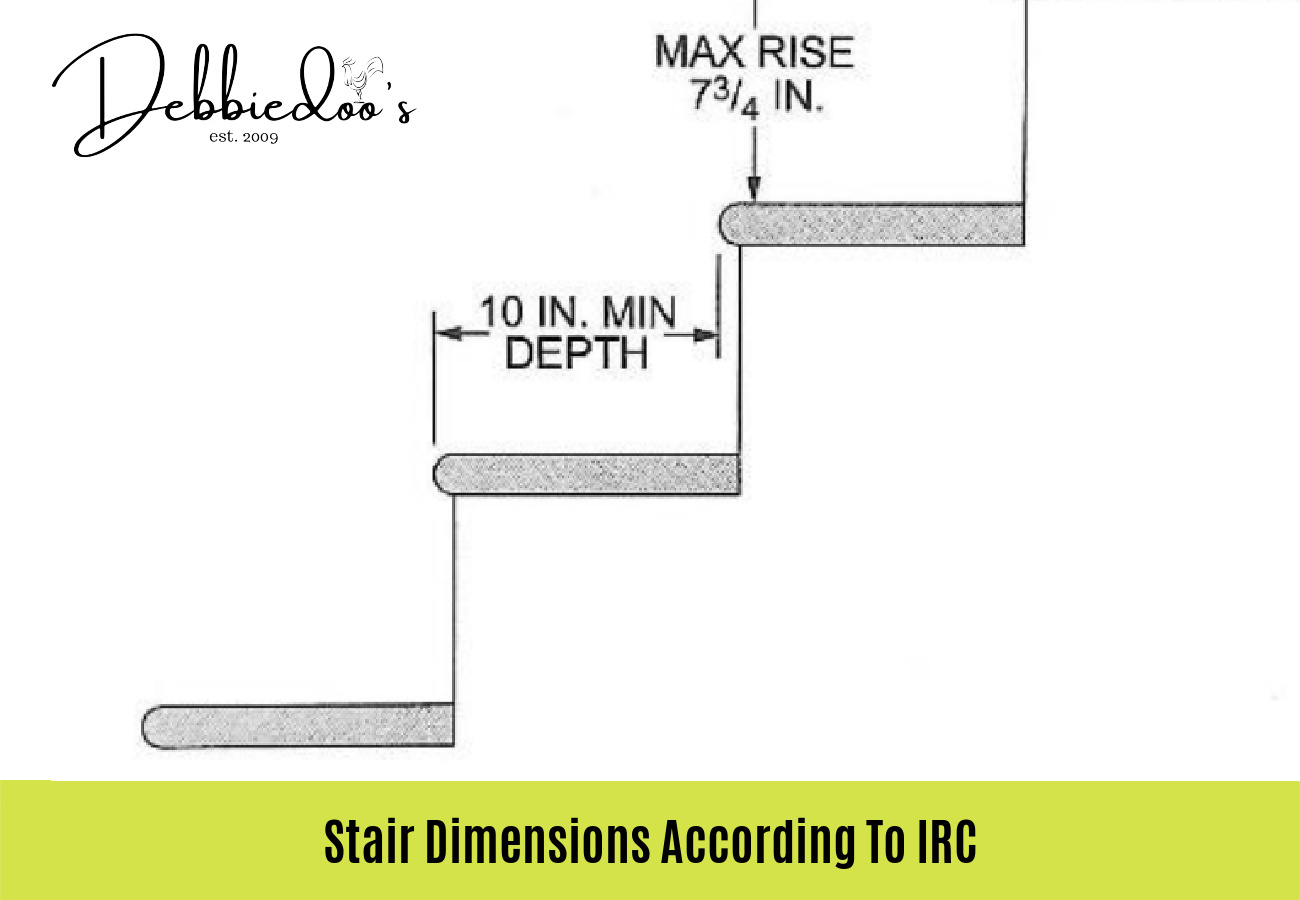When constructing a new home or making a few renovations to change its layout, building the stairs to the correct dimensions will save you a lot of hassle down the line when it comes to comfort, functionality, and safety. There’s no need to guess since the International Residential Code (IRC) provides clear guidelines for stair dimensions.

| Measurement | Inches / cm |
| Standard stair width | 36 / 91.4 |
| Standard tread depth | 10 / 25.4 |
| Maximum riser height | 7.75 / 19.7 |
| Stair width (excluding handrails) | 36 / 91.4 |
| Stair tread depth | 10 / 25.4 |
| Egress stair width | 36 / 91.4 |
| Egress tread depth | 10 / 25.4 |
| Egress riser height | 7.75 / 19.7 |
| Spiral staircase minimum tread width (at 12 inches / 30.5 cm) | 7.5 / 19 |
| Spiral staircase maximum riser height | 9.5 / 24.1 |
| Spiral staircase minimum tread radius | 26.5 / 67.3 |
| Switchback stair width | 36 / 91.4 |
| Switchback tread depth | 10 / 25.4 |
| Switchback riser height | 7.75 / 19.7 |
| Stair railing height | 34-38 / 86.4-96.5 |
| Maximum baluster spacing | 4 / 10.2 |
Standard stair dimensions
The IRC suggests a typical staircase should be about 36 inches (91.4 cm) wide. Each step, or tread, should be at least 10 inches (25.4 cm) deep. Meanwhile, the vertical gap between the steps (the riser) shouldn’t be more than 7.75 inches (19.7 cm) high.
Stair width dimensions
Stairs should be wide enough not only for people to use comfortably and safely but also for moving furniture or appliances. In this spirit, IRC specifies a stair width of at least 36 inches (91.4 cm) wide, excluding handrails.
Stair tread dimensions
The tread is the horizontal part of the stair, and it must be deep enough to safely step on the tread with the entire foot when walking or running, not just the tip. As such, IRC indicates a stair tread depth of at least 10 inches (25.4 cm).
Stair stringer sizes
Also known as a “string” or “stringer board,” a stair stringer is the part that covers the sides of the stairs. It’s optional, so there are staircase models that don’t have it. The IRC doesn’t set a specific size for these. On the other hand, the rulebook mentions the string must be strong enough to carry the weight of both the stairs and anyone using them.
Stair riser sizes
A stair riser is the vertical surface that supports the tread. Like stringer boards, staircases sometimes lack risers. According to IRC, stair risers can’t be more than 7.75 inches (19.7 cm) high. Smaller riser heights are usually more comfortable, but anything higher will make climbing a burden.
Egress stair dimensions
Egress stairs are used for emergencies, allowing people to exit a building quickly. The IRC says these stairs must be the same size as regular stairs: 36 inches (91.4 cm) wide, treads at least 10 inches (25.4 cm) deep, and the risers 7.75 inches (19.7 cm) high at most.
Spiral staircase dimensions
Spiral staircases have slightly different size specifications than regular ones. According to the IRC, they must have a minimum tread width of 7.5 inches (19 cm) at 12 inches (30.5 cm) from where the treads narrow. The maximum riser height is 9.5 inches (24.1 cm), and each tread must have a minimum radius of 26.5 inches (67.3 cm).
Switchback stair dimensions
Switchback stairs, named for their sharp turns, have the same IRC size requirements as standard and egress stairs: 6 inches (91.4 cm) wide, treads at least 10 inches (25.4 cm) deep, and the risers 7.75 inches (19.7 cm) high at most.
Stair railing dimensions
Stair railings are correctly measured vertically from the nosing of the treads, and the IRC specifies a height of 34 – 38 inches (86.4 – 96.5 cm). Additionally, the space between balusters (the vertical bars in the railing) mustn’t exceed 4 inches (10.2 cm) so kids can’t accidentally squeeze through.

